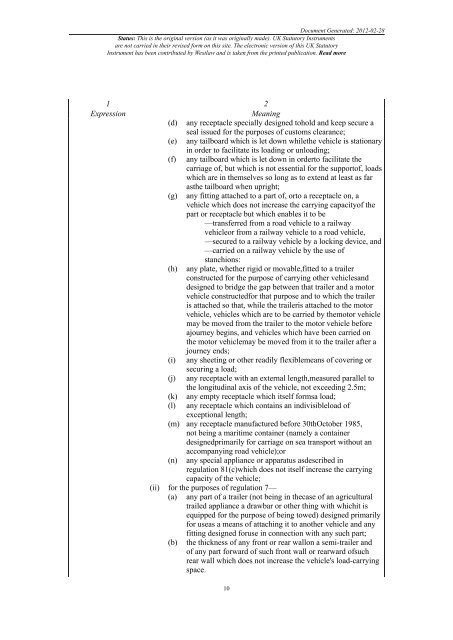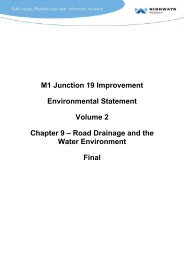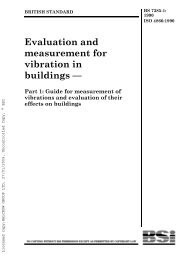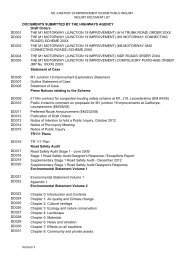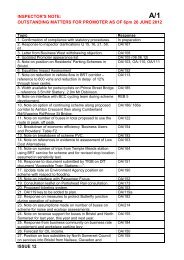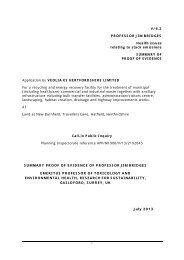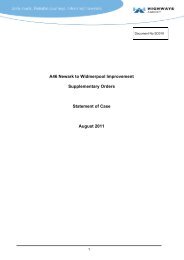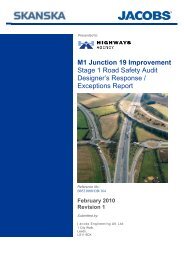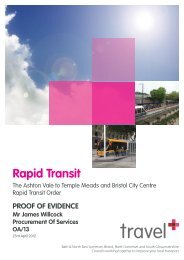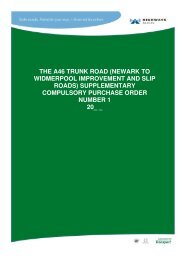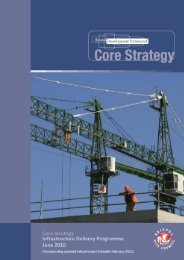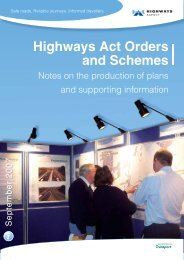The Road Vehicles (Construction and Use) Regulations 1986
The Road Vehicles (Construction and Use) Regulations 1986
The Road Vehicles (Construction and Use) Regulations 1986
Create successful ePaper yourself
Turn your PDF publications into a flip-book with our unique Google optimized e-Paper software.
Document Generated: 2012-02-28<br />
Status: This is the original version (as it was originally made). UK Statutory Instruments<br />
are not carried in their revised form on this site. <strong>The</strong> electronic version of this UK Statutory<br />
Instrument has been contributed by Westlaw <strong>and</strong> is taken from the printed publication. Read more<br />
1 2<br />
Expression<br />
Meaning<br />
(d) any receptacle specially designed tohold <strong>and</strong> keep secure a<br />
seal issued for the purposes of customs clearance;<br />
(e) any tailboard which is let down whilethe vehicle is stationary<br />
in order to facilitate its loading or unloading;<br />
(f) any tailboard which is let down in orderto facilitate the<br />
carriage of, but which is not essential for the supportof, loads<br />
which are in themselves so long as to extend at least as far<br />
asthe tailboard when upright;<br />
(g) any fitting attached to a part of, orto a receptacle on, a<br />
vehicle which does not increase the carrying capacityof the<br />
part or receptacle but which enables it to be<br />
—transferred from a road vehicle to a railway<br />
vehicleor from a railway vehicle to a road vehicle,<br />
—secured to a railway vehicle by a locking device, <strong>and</strong><br />
—carried on a railway vehicle by the use of<br />
stanchions:<br />
(h) any plate, whether rigid or movable,fitted to a trailer<br />
constructed for the purpose of carrying other vehicles<strong>and</strong><br />
designed to bridge the gap between that trailer <strong>and</strong> a motor<br />
vehicle constructedfor that purpose <strong>and</strong> to which the trailer<br />
is attached so that, while the traileris attached to the motor<br />
vehicle, vehicles which are to be carried by themotor vehicle<br />
may be moved from the trailer to the motor vehicle before<br />
ajourney begins, <strong>and</strong> vehicles which have been carried on<br />
the motor vehiclemay be moved from it to the trailer after a<br />
journey ends;<br />
(i) any sheeting or other readily flexiblemeans of covering or<br />
securing a load;<br />
(j) any receptacle with an external length,measured parallel to<br />
the longitudinal axis of the vehicle, not exceeding 2.5m;<br />
(k) any empty receptacle which itself formsa load;<br />
(l) any receptacle which contains an indivisibleload of<br />
exceptional length;<br />
(m) any receptacle manufactured before 30thOctober 1985,<br />
not being a maritime container (namely a container<br />
designedprimarily for carriage on sea transport without an<br />
accompanying road vehicle);or<br />
(n) any special appliance or apparatus asdescribed in<br />
regulation 81(c)which does not itself increase the carrying<br />
capacity of the vehicle;<br />
(ii) for the purposes of regulation 7—<br />
(a)<br />
(b)<br />
any part of a trailer (not being in thecase of an agricultural<br />
trailed appliance a drawbar or other thing with whichit is<br />
equipped for the purpose of being towed) designed primarily<br />
for useas a means of attaching it to another vehicle <strong>and</strong> any<br />
fitting designed foruse in connection with any such part;<br />
the thickness of any front or rear wallon a semi-trailer <strong>and</strong><br />
of any part forward of such front wall or rearward ofsuch<br />
rear wall which does not increase the vehicle's load-carrying<br />
space.<br />
10


